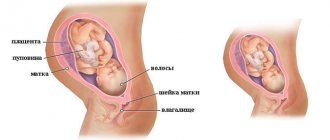Body changes and new sensations for women
Now, at 31 weeks, a woman may encounter such an unpleasant disease as hemorrhoids during pregnancy.
The risk of developing the disease increases as you approach the cherished “X” hour. Most often, hemorrhoids appear due to an enlarged uterus, which strongly compresses the inferior vena cava, which leads to stagnation of blood in the vessels of the legs and rectum. Add to this the sedentary lifestyle of expectant mothers, as well as the increased frequency of constipation that occurs due to poor nutrition and a significant decrease in intestinal tone while waiting for the baby. How can you treat hemorrhoids during pregnancy? Start with preventive measures - adjust your menu, eliminate constipation, normalize bowel movements and do not forget to observe the rules of personal hygiene (after each “big” trip, thoroughly rinse the perineum and anus area). However, in some cases it is no longer possible to do without special medications - suppositories, ointments, gels, creams, etc. (their use during pregnancy is possible only after consultation with a doctor!).
Necessary studies and analyzes
A gynecologist examines a pregnant woman once every two weeks; therefore, every two weeks the pregnant woman undergoes a urine test. Sometimes it is on the basis of the results of OAM that the doctor can make a diagnosis of pyelonephritis, as well as confirm the development of gestosis in a woman. If the expectant mother is at risk of developing anemia, she also undergoes a general blood test, the results of which will show the level of hemoglobin. According to indications, she can take blood tests for sugar, antibody titer (if we are talking about the presence of Rh conflict), as well as for various sexually transmitted infections.
When examining a woman, the gynecologist evaluates the following parameters:
- abdominal circumference and height of the uterine fundus;
- the baby's heartbeat, which is heard using an obstetric stethoscope;
- blood pressure and weight of the pregnant woman;
- condition of the cervix during vaginal examination;
- general well-being of the woman;
- results of tests, conclusions of specialists.
If a woman has signs of developing gestosis, the gynecologist can give her a referral to a hospital in order to stabilize the pregnant woman’s condition and save the baby’s life.
Weight gain
Rapid weight gain (more than 450–500 g per week), edema can signal the appearance of such a dangerous disease as late toxicosis (preeclampsia) at this time. The most unpleasant thing for the fetus during gestosis is that the mother’s placenta, along with her arms and legs, may swell, causing oxygen access to the baby to significantly decrease. And for a woman, gestosis during pregnancy is fraught with heart attack, stroke, pulmonary edema, and also kidney and liver failure. So be very careful and pay close attention not to overeat, since obesity is a direct path to late toxicosis! As for weight norms, by the end of 31 weeks the total weight gain for women of normal build is usually about 9.5 kg.
Recommendations for the expectant mother
The expectant mother needs to listen to her body. But at the same time, enjoy your pregnancy and experience positive emotions.
Yoga is a great exercise for pregnant women
- It is important to get proper rest and walk in the fresh air. It is advisable to find an opportunity for daytime sleep.
- Lifting weights is prohibited. This can trigger premature birth. But moderate physical activity is required.
- It is required to visit a gynecologist on the appointed dates.
- It is necessary to control your weight. If it is excessive, swelling and digestive problems may appear.
- To reduce the load on the spine, the back muscles must be worn with an orthopedic bandage.
- To prevent stretch marks, you can rub warm vegetable oil into the skin of the abdomen, thighs and chest.
Is it possible to have sex
Intimate relationships can be continued at this time. It is important that the expectant mother does not feel unwell, has no contraindications or doctor’s prohibitions.
The gynecologist may prescribe sexual rest. It is necessary for multiple pregnancies, where there is a risk of premature birth.
Mom's belly
Mom's belly continues to grow at 31 weeks. The uterus, which has increased in size, already fills most of it. The nature of the baby's kicks also changes - due to the fact that the baby becomes cramped in the womb, they become less active, but more painful for the mother. As before, the stomach may become hard, which is a sign of uterine hypertonicity during pregnancy (be sure to tell your doctor about unpleasant sensations!), as well as itch (this is due to stretched skin, which needs active hydration when itching).
Nutrition
Nutrition of a pregnant woman at the 31st week
At the 31st week of pregnancy, a woman should devote enough time and attention to the issue of nutrition in order to avoid and reduce unpleasant manifestations caused by the pressure of the uterus on the gastrointestinal tract. Following some rules and maintaining the balance of nutrients entering the body is an important step towards a successful pregnancy.
Nutrition rules:
- eat often, but not much. Ideally, eat 5-6 times a day, every 2-2.5 hours;
- stop eating until you feel full;
- do not mix different dishes at one meal;
- The last hearty dinner is 2-3 hours before bedtime. If necessary, curb your appetite with yogurt or fruit;
- drink about 1.5 liters of fluid per day, unless the gynecologist prescribes otherwise;
- exclude harmful foods, avoid semi-finished products, pickles, smoked foods, dried foods;
- completely avoid strong tea and coffee, unless otherwise prescribed by the gynecologist;
- consume a minimum of salt.
A pregnant woman's diet should contain the most varied amount of nutrients. To achieve this, it is a good idea to follow the recommended diet plan:
- have breakfast with porridge;
- for lunch, eat meat or fish with vegetables;
- have a light dinner;
- snack on vegetables or fruits (raw, boiled), nuts, dried fruits.
At the 31st week, a woman should make sure that her body receives foods containing:
- calcium (dairy products, almonds, bananas);
- magnesium (buckwheat, brown rice, chicken eggs);
- vitamin D (beef liver, chicken eggs, sea fish);
- iron (red meats and offal, apples, egg yolks);
- phosphorus (cheese, cereals, broccoli);
- iodine (sea fish, prunes, seaweed, cranberries);
- folic acid (asparagus, organ meats, broccoli);
- vitamin A (carrots, pumpkin, liver, apples);
- B vitamins (red meats, bananas, almonds);
- vitamin C (cauliflower, broccoli, black currant);
- vitamin E (asparagus, fruits, broccoli, fish).
Vitamins
Taking multivitamin complexes and dietary supplements at the 31st week of pregnancy should be strictly as prescribed by the doctor. When choosing a suitable vitamin preparation, the doctor will rely on the characteristics of the region, tests of the pregnant woman, her medical history and other factors. It should be remembered that excessive consumption of vitamins can lead to serious consequences, as well as a lack of essential elements.
Nutrition at 31 weeks of pregnancy
If an expectant mother at 31 weeks is faced with a phenomenon such as hemorrhoids, she simply needs to slightly adjust her diet. It is clear that during pregnancy she got used to eating properly and nutritiously. Now she should only slightly diversify her menu with products that contain coarse plant fiber (vegetables, fruits, dried fruits, cereals, cereals), and also increase the consumption of “milk” (yogurt, cream, milk, one-day kefir ). In addition, you should avoid spicy and fatty foods, seasonings, white bread and sweets (primarily this applies to custard cakes with cream).
Mother. Changes in the state of the body at 31 weeks
Condition of the mother at the 31st week of pregnancy
Just a week ago, it seemed to the woman that, having gone on maternity leave, she would finally be able to rest and sleep, but the reality in most cases turns out to be different. With free time comes new challenges.
Maternity leave is granted at the end of the third trimester based on labor legislation. Fatigue, clumsiness, difficulty in moving are difficulties that do not allow a woman to perform her job duties well. Life inside the expectant mother continues to grow, exerting an increasing influence on the condition of the parent.
Psychological problems: fears
The approach of childbirth often causes psychological problems: fears appear. A woman can be frightened both by the process of childbirth and by the events that will occur before and after it. Often, at an appointment with a gynecologist, the question is asked: “What should I do if labor begins not at home, but, for example, while walking?”, “How to determine that you need to go to the maternity hospital?”, “And if something goes wrong during childbirth?” So?". These and many other aspects can not only aggravate fear, but also lead a woman to a panic attack. How to deal with this?
Discuss your concerns with a gynecologist and follow a number of simple rules:
- Always and everywhere carry an exchange card with you. She was handed over at the last appointment. Having this document will allow you to go to the maternity hospital immediately from any place;
- Do not plan long trips before giving birth, especially to places where there is no accessible medical care;
- Remember that childbirth, especially the first one, is a long process. A woman, as a rule, has at least a few hours to get to the hospital;
- Prepare things for the maternity hospital by first dividing them into 3 separate packages:
- For childbirth;
- For the postpartum period;
- For discharge.
You need to pay attention to the requirements of the chosen maternity hospital. Lists of permitted items may vary.
- Tell your loved ones which package will be needed first and which one later, or better yet, sign;
- Attend courses for expectant mothers. As part of the courses, women are introduced to proper breathing during childbirth, features of the process, etc. Usually, experienced medical workers work with women in labor who can provide correct psychological assistance and dispel fears.
Many psychologists argue that you need to start fighting the fear of childbirth in advance and prepare yourself. One of the common techniques is to ensure sufficient awareness of upcoming events, accepting that the birth of a child is a normal physiological process through which a huge number of women have already gone through. In most cases, the body itself knows what to do, and in case something goes wrong, doctors should be nearby.
Signs of time and sensations
The general condition of a pregnant woman’s body at 31 weeks is usually satisfactory, but some signs of the period can cause significant inconvenience. It is recommended to distinguish between normal manifestations of pregnancy and symptoms that require consultation with a gynecologist or seeking medical help.
First of all, discomfort during this period is caused by an enlarged uterus. It already occupies almost the entire space from the symphysis pubis to the hypochondrium, putting pressure on the surrounding organs. As a result:
- urination becomes more frequent. This week, urinary incontinence when sneezing or coughing may be added to the frequent urge to go to the toilet. To avoid getting into an unpleasant situation, it is advisable to use panty liners without fragrances or other additives. This sign of a period is normal and does not require consultation with a specialist if it is not accompanied by itching or pain in the perineum.
- heartburn, constipation, heaviness in the stomach, flatulence . You can fight heartburn and heaviness in the stomach by following the rules of nutrition (more details in the section “Nutrition”). Drinking small amounts of milk, carrot and grapefruit juice can help relieve heartburn. To avoid constipation, it is recommended to include dried apricots and prunes in your diet. If stool is delayed for more than 2 days, consult a gynecologist.
- shortness of breath, inability to take a deep breath, shortness of breath. The fundus of the uterus is located directly under the ribs, compressing the lungs and diaphragm. The feeling of having difficulty breathing is normal. It is recommended to frequently ventilate the room in which the pregnant woman is located, and to walk outside every day. This sign of term will be observed until the last weeks of pregnancy, when the stomach begins to drop down, the baby will prepare for childbirth.
- stretch marks. The third trimester is the period when the belly is actively growing. Every week it increases by 1 cm. It is possible to reduce the likelihood of stretch marks with the help of enhanced skin care. To do this, you can use olive oil or a special cream for stretch marks recommended by a gynecologist.
- navel protruding above the abdomen. Some women who have noticed that with the enlargement of their belly, their navel has not only changed its location (is higher), but has also begun to protrude forward, this change is frightening. Don't worry, this is normal for 31 weeks of pregnancy. After childbirth everything will come back.
The listed sensations and changes in the body occur in most women and do not require additional consultation with a specialist. You need to contact a gynecologist who is observing a pregnant woman if:
- there is a burning sensation or pain when urinating;
- the color of the urine has become dark, cloudy, mixed with flakes;
- pain is felt at the lumbar level on the sides;
- swelling appears in the arms, legs or face. In the evenings and at night, cramps and pain in the legs disturb;
- there is a headache or heaviness in the occipital region of the head caused by changes in blood pressure;
- hemorrhoids appeared or worsened. During and before defecation, pain is observed in the anus, small spots of blood are noticeable in the stool;
- varicose veins of the legs worsened, spider veins began to form;
- there is severe dizziness with nausea;
- Nails began to peel, hair fell out, and vision deteriorated sharply.
These signs are the most common, but each female body is unique and can react to pregnancy in its own way. If a sign that appears brings discomfort, interferes with normal life, frightens or worries, you should tell your gynecologist about it.
Movements and position of the baby in the uterus
At the 31st week, the baby became larger, and it became more and more difficult for him to toss and turn in the mother’s womb. Most babies are already in a head down position, which is the most suitable option for birth.
Other bellies may still be across or upside down. It should be noted that if at the time of birth, the baby takes a position across the uterus or with its legs down, this may become the basis for a caesarean section. To reduce the likelihood of such an outcome, the expectant mother should make an attempt to tell the baby how to lie down correctly in the stomach. There are many techniques and ways to do this, but before using them you need to consult a gynecologist.
During this week of pregnancy, a woman should continue to count the kicks and movements of the fetus. Unlike earlier periods, at the 31st week the baby moves less often. Normally, the expectant mother should feel at least 10 tremors in 12 hours .
Lifestyle
And again we return to the topic of “hemorrhoids during pregnancy” - many mothers are really worried about this problem! At week 31, we offer you a set of special exercises - simple and safe, they will allow pregnant women to avoid the development of an unpleasant disease, and will also improve the functions of the large intestine and reduce congestion in the pelvic veins. Exercises must be performed for 5 minutes 2-3 times a day.
- In a standing position, alternately swing (not sharply!) your left/right leg back, forward, and to the sides.
- In a sitting position, spread your legs to the sides as much as possible and make several shallow bends forward (it is advisable not to bend your knees, but press your heels firmly to the floor).
- Squeeze your buttocks and draw in your pelvic floor muscles. It is better to perform this exercise while sitting on a hard chair or standing with your legs crossed.
If you feel unwell during exercise, immediately stop exercising, lie on your side and try to relax.
Possible problems
- Standard pregnancy problems include increased fatigue, shortness of breath, heartburn and constipation, abdominal and lumbar pain, as well as headaches, sudden mood swings and fear of childbirth, inconvenience associated with insomnia and the choice of sleeping position. Pregnant women are gradually getting used to them and are already finding their own ways to ease their well-being.
- Fetoplacental insufficiency. This is a condition of the placenta in which blood flow in it is disrupted. This can not only affect the baby's development, but also his vitality. There are many types of FPN, but if it is detected in a timely manner through various studies and tests, doctors can prescribe the necessary treatment and ensure the full development of the fetus.
- Preeclampsia. This syndrome is otherwise called preeclampsia. It’s worth saying right away that women with gestosis need to be kept in the pregnancy pathology department, since further development of this syndrome can lead to death if left untreated and always requires emergency delivery. How is gestosis detected? The woman notices the occurrence of headaches and dizziness, her blood pressure rises significantly and swelling develops. Nausea at 31 weeks of pregnancy can also be one of the symptoms of gestosis. Also, urine test results show increased protein levels. With the further development of symptoms, the following condition occurs - eclampsia. It is characterized by the development of convulsions and loss of consciousness, up to coma. That is why it is important for pregnant women to monitor their well-being and contact a gynecologist in a timely manner.
Diarrhea at 31 weeks of pregnancy
There are many reasons for this phenomenon, from simple poisoning to hormonal fluctuations. But a woman needs to correct her condition as soon as possible in order to prevent the development of dehydration due to the loss of a large volume of fluid. To do this, you need to drink enough (water, tea), and you can also prepare yourself a liquid rice porridge with water. Rice starch will help improve intestinal health. If diarrhea continues for a long time, visit a gastroenterologist to be prescribed medications to treat diarrhea.
Cold at 31 weeks of pregnancy
If you feel unwell, have a runny nose and cough, and also notice a rise in temperature, most likely you are developing a cold. In this case, you should switch to home mode. And it is advisable to spend more time in bed for a speedy recovery. In this case, you need to provide yourself with plenty of warm drinks and symptomatically treat a runny nose and sore throat. You can reduce a high temperature (if it is above 38 degrees) by taking a paracetamol tablet.
The belly becomes hard at 31 weeks of pregnancy
This condition of the uterus occurs when the pregnant woman exercises excessively, during long walking, it can be provoked by sudden movements of the woman, as well as falls. If there are no pregnancy complications, the increased tone of the uterus will soon disappear. To do this, you need to lie on your side and spend some time in this position. If the tone of the uterus is increased, nagging pain appears in the lower part of the uterus or in the lower back, and specific discharge appears (profuse, watery or mixed with blood), you need to urgently call an ambulance, because this may indicate premature birth.
Childbirth at 31 weeks of pregnancy
Of course, many of the baby’s organ systems are already quite well developed. However, it is not enough to function outside the mother’s body. At the same time, babies born at this stage almost always survive and develop quickly with the support of doctors and special equipment, and then just as quickly catch up with their peers in development.
Beauty and accessories
Is your baby due to be born during the cold season? This means that at 31 weeks the mother can already look for a babywearing jacket that is very fashionable today. This unique jacket, designed by loving mothers, with a special insert on the front, allows you to carry your baby underneath in a sling or backpack. If the insert is unfastened, the jacket becomes the most ordinary and traditional one. Note that this option is suitable only for those women who, in the first months after the birth of the baby, will actively use slings to carry their babies in them.









